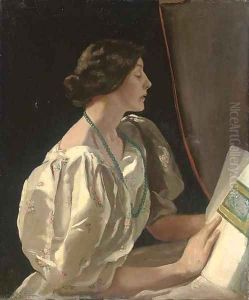Sir John Lavery Paintings
Sir John Lavery was a renowned Irish painter best known for his portraits and wartime depictions. Born on March 20, 1856, in Belfast, Northern Ireland, Lavery became orphaned at a young age. His upbringing was marked by the loss of his parents, which led to him being raised by relatives. Despite these early hardships, Lavery showed an early interest in art and would go on to become one of the most celebrated artists of his time.
Lavery's initial artistic education began at the Haldane Academy in Glasgow. His talent and dedication to his craft earned him a place at the prestigious Glasgow School of Art, where he further honed his skills. He also studied in London and later in Paris at the Académie Julian, which was a significant art hub during the late 19th century. There, he was influenced by the work of the Impressionists, which would have a lasting impact on his style, characterized by a luminous palette and a preference for capturing the effects of light.
Upon returning to Glasgow, Lavery became associated with the Glasgow Boys, a group of artists who aimed to infuse realism and naturalism into their works, moving away from the academic painting traditions of the time. His early works often depicted everyday scenes and landscapes, but it was his portraiture that would garner him the most acclaim.
In 1888, Lavery's career was significantly boosted when his painting 'The Tennis Party' was exhibited at the Royal Academy in London. This work captured the leisurely activities of the upper classes with a freshness and vivacity that resonated with audiences and critics alike. His reputation as a portrait artist grew, and he painted many notable figures of his time, including politicians, royalty, and celebrities. In 1900, he married Hazel Martyn, an American who frequently featured in his paintings and was known as the 'most beautiful woman in Europe'.
Lavery's prominence extended beyond the art world. During World War I, he was appointed as an official war artist. His wartime depictions provided a unique and personal perspective on the conflict. Later, his Irish heritage led him to document significant historical moments, such as the Irish War of Independence and the signing of the Anglo-Irish Treaty, where his painting of the event remains one of the iconic representations of that period.
Lavery was knighted in 1918 for his contributions to art and was later elected as a member of the Royal Academy. His works have been exhibited worldwide and continue to be appreciated for their elegance and portrayal of light. He passed away on January 10, 1941, in Rossenara House, Kilmoganny, County Kilkenny in Ireland, leaving behind a legacy as one of Ireland's most distinguished and influential artists.
